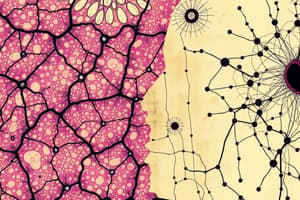Podcast
Questions and Answers
What is one of the characteristics of PET imaging?
What is one of the characteristics of PET imaging?
- Inexpensive
- High spatial resolution
- Temporally fast
- Useful for targeting specific systems (correct)
Which of the following is a challenge associated with interpreting fMRI studies?
Which of the following is a challenge associated with interpreting fMRI studies?
- Excessive cost
- Confounding factors like anxiety and boredom (correct)
- Poor spatial averaging
- Limited availability of equipment
What response does fMRI measure through the BOLD technique?
What response does fMRI measure through the BOLD technique?
- Electroencephalographic response
- Magnetic field changes
- Hemodynamic response (correct)
- Neuronal firing rate
What is a limitation of PET imaging when compared to fMRI?
What is a limitation of PET imaging when compared to fMRI?
Which statement reflects a misconception regarding the default mode network?
Which statement reflects a misconception regarding the default mode network?
What potential issue arises from using paired image subtraction in fMRI studies?
What potential issue arises from using paired image subtraction in fMRI studies?
What does regional hemodynamics refer to in the context of fMRI?
What does regional hemodynamics refer to in the context of fMRI?
What is one characteristic of event-related fMRI that distinguishes it from traditional fMRI methods?
What is one characteristic of event-related fMRI that distinguishes it from traditional fMRI methods?
What is the primary use of transcranial magnetic stimulation in research?
What is the primary use of transcranial magnetic stimulation in research?
Which of the following behavioural assays is known to have difficulties in interpretation?
Which of the following behavioural assays is known to have difficulties in interpretation?
Why are animal models used in neuroscience research?
Why are animal models used in neuroscience research?
What is the most common route for delivering drugs in neuroscience research?
What is the most common route for delivering drugs in neuroscience research?
Which invasive electrophysiological recording method involves placing electrodes directly inside neurons?
Which invasive electrophysiological recording method involves placing electrodes directly inside neurons?
What is the purpose of stereotaxic surgery in neuroscience research?
What is the purpose of stereotaxic surgery in neuroscience research?
What characterizes reversible lesions in neuroscience studies?
What characterizes reversible lesions in neuroscience studies?
What is a common reference point used in stereotaxic surgery?
What is a common reference point used in stereotaxic surgery?
What is the primary use of optogenetics in research?
What is the primary use of optogenetics in research?
Which imaging technique is specifically classified as dynamic?
Which imaging technique is specifically classified as dynamic?
What is a primary advantage of using Magnetic Resonance Imaging (MRI) compared to Computed Tomography (CT)?
What is a primary advantage of using Magnetic Resonance Imaging (MRI) compared to Computed Tomography (CT)?
What does Diffusion Tensor Imaging (DTI) primarily assess in the brain?
What does Diffusion Tensor Imaging (DTI) primarily assess in the brain?
Which type of staining technique can be inserted into living cells?
Which type of staining technique can be inserted into living cells?
What is the main limitation of Computed Tomography (CT) imaging?
What is the main limitation of Computed Tomography (CT) imaging?
Which stain would be most appropriate for visualizing myelinated fibers in the brain?
Which stain would be most appropriate for visualizing myelinated fibers in the brain?
What is the primary purpose of neuroimaging techniques?
What is the primary purpose of neuroimaging techniques?
Flashcards
Transcranial Magnetic Stimulation (TMS)
Transcranial Magnetic Stimulation (TMS)
A technique that uses magnetic pulses to stimulate or inhibit specific brain regions, creating "virtual lesions" for studying brain function.
Animal Models in Neuroscience
Animal Models in Neuroscience
Animal studies used to examine brain function, behavior, and potential therapeutic targets.
Forced-Swim Test (FST)
Forced-Swim Test (FST)
A behavioral test used in animal models, but often criticized for its interpretation and reliability in measuring depression.
Drug Challenge in Animal Models
Drug Challenge in Animal Models
Signup and view all the flashcards
Invasive Electrical Recording Methods
Invasive Electrical Recording Methods
Signup and view all the flashcards
Stereotaxic Surgery
Stereotaxic Surgery
Signup and view all the flashcards
Lesion Methods
Lesion Methods
Signup and view all the flashcards
Ideal Post-Surgery Testing Window
Ideal Post-Surgery Testing Window
Signup and view all the flashcards
PET: indirect measure
PET: indirect measure
Signup and view all the flashcards
Paired image subtraction
Paired image subtraction
Signup and view all the flashcards
fMRI: BOLD response
fMRI: BOLD response
Signup and view all the flashcards
Event-related fMRI
Event-related fMRI
Signup and view all the flashcards
Default mode network
Default mode network
Signup and view all the flashcards
Regional hemodynamics
Regional hemodynamics
Signup and view all the flashcards
Confounds in fMRI
Confounds in fMRI
Signup and view all the flashcards
Anticipatory hemodynamics
Anticipatory hemodynamics
Signup and view all the flashcards
Optogenetics: What is it?
Optogenetics: What is it?
Signup and view all the flashcards
X-ray: What is it?
X-ray: What is it?
Signup and view all the flashcards
Computed Tomography (CT)
Computed Tomography (CT)
Signup and view all the flashcards
Magnetic Resonance Imaging (MRI)
Magnetic Resonance Imaging (MRI)
Signup and view all the flashcards
Diffusion Tensor Imaging (DTI)
Diffusion Tensor Imaging (DTI)
Signup and view all the flashcards
Stains in Neuroscience
Stains in Neuroscience
Signup and view all the flashcards
Green Fluorescent Protein (GFP)
Green Fluorescent Protein (GFP)
Signup and view all the flashcards
Study Notes
Tools in Neuroscience Research
- Transcranial magnetic stimulation (TMS) is used to create "virtual lesions" and has potential therapeutic applications.
- Animal models include the Morris water maze, 5-choice serial reaction time task, conditioning (classical and operant), and the T-maze.
- The forced-swim test (FST) is a behavioral assay used to measure depression in rodents and evaluate antidepressant efficacy. However, interpretation can be challenging.
- Animal models are used because mammalian brain similarities exist, and animal cognition is sophisticated.
- Potential drug routes include intramuscular (IM), intravenous (IV), subcutaneous (SC), intraperitoneal (IP), and intraventricular.
- Multiple drug doses, often starting with saline, are crucial for effective studies, along with control groups. The within-subjects design is commonly used to enhance these studies.
Invasive Electrical Recording Methods
- Four invasive electrophysiological methods include intracellular unit recording, extracellular unit recording, multiple-unit recording, and invasive EEG recording.
Stereotaxic Surgery
- Stereotaxic surgery, used for lesions, optogenetics, and electrode implantation, employs a stereotaxic atlas and instrument.
- Precise placement is enabled by the stereotaxic atlas and instrument, including the use of bregma as a reference point.
Lesion Methods
- Chemical lesions, such as quinolinic acid and ibotenic acid, are excitotoxic.
- Selective chemical lesions include 6-hydroxydopamine (6-OHDA) and 5,7-dihydroxytriptamine (5,7-DHT).
- Reversible lesions can be achieved using cannulae and methods like baclofen + muscimol, which are beneficial because of the within-subjects design.
- Different lesion approaches (unilateral, bilateral, or contralateral) in studies should be carefully considered.
Optogenetics
- Optogenetics introduces light-gated ion channels, such as channelrhodopsins.
- System-specific transcription factors can be used.
- Optogenetics can be used for recording/mapping and manipulation.
Reminder: Stains are Cool
- Golgi stain, Nissl stain/cresyl violet stain, and fiber stains are useful tools.
- Luxol-fast blue (LFB) and toluidine blue are specific fiber stains.
- Green fluorescent protein (GFP) derivatives (e.g., YFP, BFP) can be introduced into living cells for imaging studies.
Neuroimaging: Structural and Functional
- Static (structural) neuroimaging includes computerized axial tomography (CAT/CT), magnetic resonance imaging (MRI), and diffusion tensor imaging (DTI).
- Dynamic (functional) neuroimaging includes positron emission tomography (PET), functional MRI (fMRI), and resting-state functional connectivity MRI (rsfcMRI).
X-Ray
- X-ray imaging uses an X-ray tube, beam, and film or detectors to produce images.
Computed Tomography (CT)
- CT involves a tube and detector for imaging.
- Early CT was limited by its algorithm quality but useful for stroke studies.
Magnetic Resonance Imaging (MRI)
- MRI, utilizing the rotation of hydrogen atoms' protons in a magnetic field, provides structural brain imaging.
- The technology produces detailed images based on aligning protons in a magnetic field.
Diffusion Tensor Imaging (DTI)
- DTI is a variant of MRI that focuses on water molecule movement to produce images of brain tracts.
Positron Emission Tomography (PET)
- PET uses radiolabeled molecules (e.g., cocaine) to visualize brain activity, often indirectly.
- This method is less common now due to cost and time constraints, but provides valuable insight into targeted brain systems.
- PET uses paired image subtraction (as fMRI) but with its own unique limitations.
Functional MRI (fMRI)
- fMRI measures blood oxygenation changes associated with neuronal activity. This is called the BOLD response.
- fMRI, like PET, often employs paired image subtraction techniques to analyze data. Event-related fMRI designs are now common for reducing some of these biases.
- fMRI has some limitations that must be considered when interpreting results. These include issues like spatial averaging, spatial and temporal resolution, and focusing on increases in activity. The default mode network (DMN) is more active during rest/passive states than task states in some regions. These methods are often not without confounding issues that influence the interpretation of data.
Studying That Suits You
Use AI to generate personalized quizzes and flashcards to suit your learning preferences.



